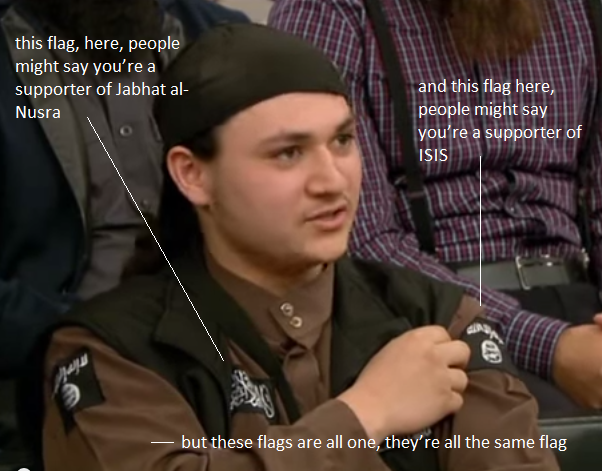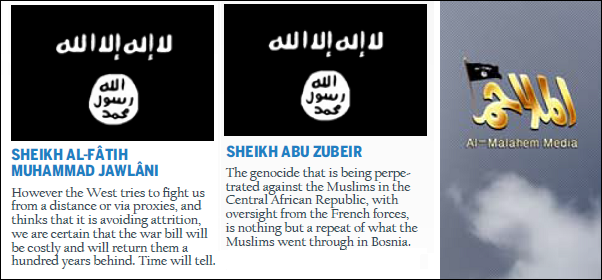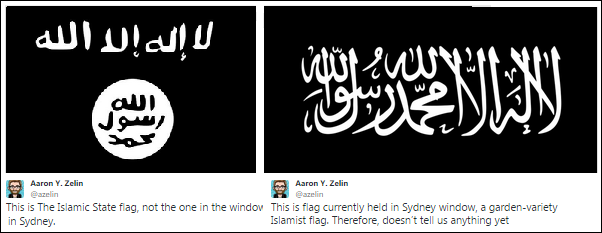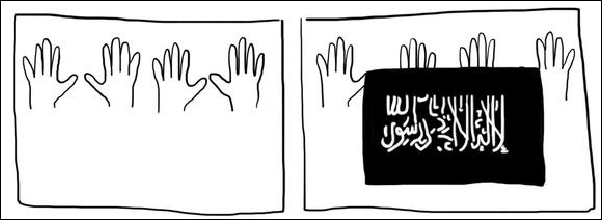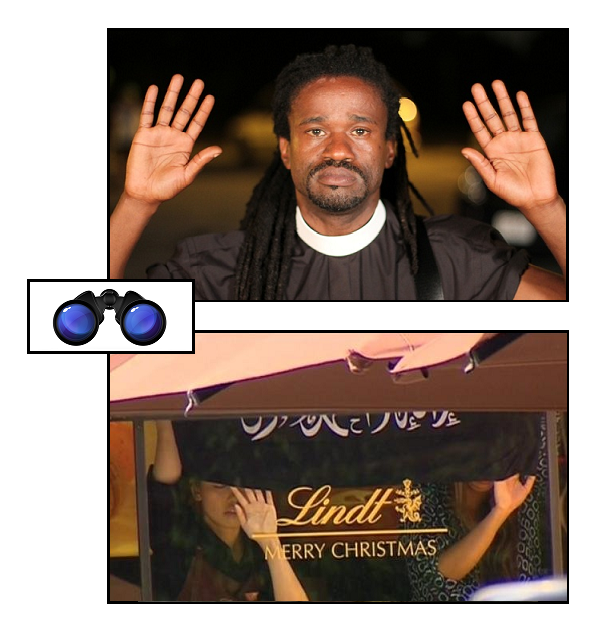On the Prophet’s banner, and the Coming One
Sunday, January 25th, 2015[ by Charles Cameron — from battle-flag to transcendent symbol ]
.
**
I have written so much on the topic of the black banners from Khorasan [eg], which in turn arguably derive from the black raya or battle-flag of the Prophet, that I thought these ahadith from the Shia text by Muhammad Baqir al-Majlisi, Bihar ul Anwar, would be of interest. They are drawn from the section titled:
Flag of the Qaim is same as the flag of the Prophet
Note here that the Qa’im — literally “He Who Arises” — is a Shia term for the Mahdi, as is Imam Zamana — “Imam of the Age”.
129- Ghaibat Nomani: It is narrated from the same chains from Abdullah bin Hammad from Abdullah bin Sinan from Abi [Abdullah] Ja’far [bin Muhammad] that he said:
“The Almighty Allah has fixed the time of the reappearance of Imam Zamana (a.s.) against the time fixed by the time-fixers. The flag of the Qaim is the same flag as that of the Prophet, which Jibraeel brought from the heavens in the Battle of Badr and he waved it during the battle.
Jibraeel said: “O Muhammad, by Allah, this flag is not of cotton, flax or silk.” I said: “Then what is it of?” He said: “It is of the leaves of Paradise. The Prophet (s.a.w.s.) spread it on the day of Badr and then he has folded it and gave it to Imam Ali (a.s.). It was still with Imam Ali (a.s.) until he spread it on the day of the battle of Jamal against the people of Basra and gained victory. Then he folded and kept it safe. It is with us and no one is to spread it until the Qaim (a.s.) appears. When he appears, he will spread it and then everyone in the east and the west will curse it. Terror will move a month before it, a month behind it, a month on its right side and a month on its left side.”
Then he said: “O Abu Muhammad, he (the Qaim) will appear depressed and angry because of the anger of Allah with the human beings. He will appear wearing the Prophet’s shirt, which the Prophet put on in the battle of Badr, turban, armor and holding the Prophet’s sword Zulfiqar. He will unsheathe the sword for eight months. He will kill excessively. [ .. ]
Here the banner is woven of no earthly cloth but of an angelic provenance…
130- Ghaibat Nomani: It is narrated from Abdul Wahid bin Abdullah from Muhammad bin Ja’far from Ibne Abil Khattab from Muhammad bin Sinan from Hammad bin Abi Talha from Thumali from Imam Muhammad Baqir (a.s.) that he said:
“Once Abu Ja’far Baqir (a.s.) said to me: “O Thabit, as if I can see the Qaim of my family coming near to your Najaf.” He pointed to Kufa and then added: “When he comes to your Najaf, he will spread the banner of the Prophet (s.a.w.s.) and then the angels of Badr will descend to him.”
I asked him: “What is the banner of the Prophet (s.a.w.s.)?” He said: “Its pole is from the pole of the Throne of Allah and from His mercy. The rest of it is from the assistance of Allah. Everything that he swoops on with this banner Allah will make it perish.” I asked: “Is it kept with you until the Qaim (a.s.) appears or it is brought then?” He said: “No. It is brought then.” I asked: “Who will bring it?” He replied: “Jibraeel (a.s.).” [ … ]
Here the banner is clearly transcendent, cosmic in scope.
134- Ghaibat Nomani: It is narrated from Ali bin Ahmad from Ubaidullah bin Musa Alawi from Muhammad bin Husain from Muhammad bin Sinan from Qutaibah Aashi from Aban bin Taghlib that he heard Imam Ja’far Sadiq (a.s.) say:
“Abu Abdullah Imam Sadiq (a.s.) said: “When the banner of the truth (the Mahdi) appears, the people of the east and the west will curse it. Do you know why?” I said: “No, I do not.” He said: “That is because of what harms the people receive from his (the Mahdi’s) family before his appearance.”
And here, one reading of the English translation would suggest that “the banner of the truth” is the Mahdi himself, though I’d need the help of a linguist to know if that’s a plausible reading in the original..
**
In any case, the first two, at any rate, are clearly referring to spiritual realities rather than exclusively to a flag of cloth, and can thus serve as correctives to a more literal understanding.

